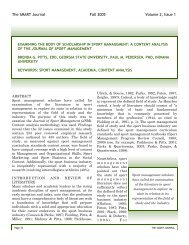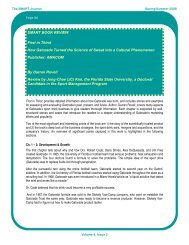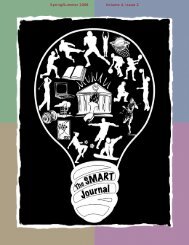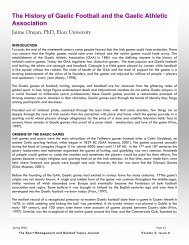beyond the myths and paradoxes of sport - The SMART Journal
beyond the myths and paradoxes of sport - The SMART Journal
beyond the myths and paradoxes of sport - The SMART Journal
You also want an ePaper? Increase the reach of your titles
YUMPU automatically turns print PDFs into web optimized ePapers that Google loves.
THE <strong>SMART</strong> JOURNAL<br />
Page 77<br />
<strong>SMART</strong> BOOK REVIEW<br />
FAIR AND FOUL: BEYOND THE MYTHS AND<br />
PARADOXES OF SPORT (3RD ED.).<br />
BY EITZEN, D.S. (2006).<br />
PUBLISHER: ROWMAN & LITTLEFIELD<br />
REVIEW BY JASON W. LEE, UNIVERSITY OF NORTH FLORIDA<br />
EDITOR, THE <strong>SMART</strong> JOURNAL<br />
D. Stanley Eitzen adds ano<strong>the</strong>r valuable addition to <strong>the</strong> fields <strong>of</strong> Sport Management <strong>and</strong> Sport Sociology<br />
with his third installment <strong>of</strong> Fair <strong>and</strong> Foul: Beyond <strong>the</strong> Myths <strong>and</strong> Paradoxes <strong>of</strong> Sport. Eitzen’s<br />
approach in this work challenges readers to examine <strong>the</strong>ir position on various matters impacting<br />
<strong>sport</strong>. Underst<strong>and</strong>ing that people should be challenged to think for <strong>the</strong>mselves, while seeking to provide<br />
answers to those items that are truly important, <strong>and</strong> seeing <strong>the</strong> extreme relevance in <strong>the</strong> study<br />
<strong>of</strong> <strong>sport</strong> <strong>and</strong> socio-cultural issues, Eitzen provides a path to cover a wide variety <strong>of</strong> issues in a probing<br />
<strong>and</strong> insightful manner. This work has <strong>the</strong> ability to <strong>of</strong>fer up new insights <strong>and</strong> exposures to <strong>the</strong> <strong>sport</strong><br />
experience while urging readers to be mindful <strong>and</strong> think more pragmatically about certain issues impacting<br />
study <strong>of</strong> <strong>sport</strong>.<br />
<strong>The</strong> contents <strong>of</strong> this book are enhanced through <strong>the</strong> use <strong>of</strong> features presented in each chapter ranging<br />
from quotes from notable <strong>sport</strong> personalities, <strong>the</strong> use <strong>of</strong> case examples at <strong>the</strong> beginning <strong>of</strong> each chapter,<br />
<strong>and</strong> through <strong>the</strong> presentation <strong>of</strong> a wealth <strong>of</strong> real life information including notable historical<br />
events <strong>and</strong> notable contemporary events. <strong>The</strong> use <strong>of</strong> <strong>the</strong>se features, intertwined with <strong>the</strong> o<strong>the</strong>r presented<br />
information, points out some important issues that for various reasons have been too commonly<br />
overlooked by students, or any o<strong>the</strong>r readers <strong>of</strong> this work. This oversight may have occurred for<br />
a variety <strong>of</strong> reasons including ignorance, misinformation, or mere apathy.<br />
<strong>The</strong> title is very reflective <strong>of</strong> <strong>the</strong> book’s contents as Eitzen implements a “fair <strong>and</strong> foul” model aimed<br />
at enlightening <strong>the</strong> readers to <strong>the</strong> dichotomy <strong>of</strong> <strong>sport</strong>, while unearthing common <strong>myths</strong> that impact<br />
<strong>sport</strong>. <strong>The</strong> fair <strong>and</strong> foul analogy is a good <strong>sport</strong> euphemism to explain <strong>the</strong> approach that recognizes<br />
that <strong>sport</strong> can mirror <strong>the</strong> human experience, while being a compelling <strong>and</strong> transcending force, while<br />
at <strong>the</strong> same time, recognizing that <strong>sport</strong> contains aspects <strong>and</strong> elements that are both positive <strong>and</strong><br />
negative.<br />
<strong>The</strong> first chapter entitled “<strong>The</strong> Duality <strong>of</strong> Sport” serves as an introduction to <strong>the</strong> rest <strong>of</strong> <strong>the</strong> book.<br />
This introductory chapter elucidates <strong>the</strong> format used in this work by identifying <strong>the</strong> duality that exists<br />
in <strong>sport</strong>. By noting that a paradox is something that is presented in a contradictory nature or something<br />
that is a commonly accepted opinion, Eitzen lays <strong>the</strong> foundation for examining diverse array <strong>of</strong><br />
topics that have <strong>and</strong> will continue to impact <strong>sport</strong>. Through challenging readers to view <strong>and</strong> think<br />
about <strong>sport</strong> critically, individuals can see <strong>the</strong> true impact that <strong>sport</strong> can have <strong>and</strong> this is a main part<br />
<strong>of</strong> this work’s true value.<br />
<strong>The</strong> subsequent chapters cover a vast array <strong>of</strong> issues <strong>and</strong> paradoxical situations existing in <strong>sport</strong>.<br />
<strong>The</strong>se chapters are:<br />
Spring 2007<br />
Volume III, Issue II
THE <strong>SMART</strong> JOURNAL<br />
Page 78<br />
• Chapter 2 is “Sport Unites, Sport Divides.” This chapter explores <strong>the</strong> potential that <strong>sport</strong> has<br />
to bring some people toge<strong>the</strong>r <strong>and</strong> provide a barricade that separate o<strong>the</strong>rs.<br />
• Chapter 3 is entitled “Names, Logos, Mascots, <strong>and</strong> Flags: <strong>The</strong> Contradictory Uses <strong>of</strong> Sports<br />
Symbols” <strong>and</strong> it examines <strong>the</strong> controversy associated with <strong>the</strong> use <strong>of</strong> potentially <strong>of</strong>fensive<br />
mascots <strong>and</strong> o<strong>the</strong>r forms <strong>of</strong> <strong>sport</strong> imagery. Though focusing primarily on Native American imagery,<br />
<strong>the</strong>re is significant coverage <strong>of</strong> Confederate symbols, <strong>and</strong> gender stereotyping as well.<br />
• Chapter 4 describes how “Sport is Fair, Sport is Foul,” through explaining <strong>the</strong> socialization<br />
process in which <strong>sport</strong> aids in achieving positive goals. This view is counteracted by examining<br />
how unethical approach can lead to an assortments <strong>of</strong> <strong>sport</strong>s ills.<br />
• Chapter 5 examines <strong>the</strong> paradox in which “Sport is Healthy, Sport is Destructive.” Clearly<br />
<strong>sport</strong> can lead to a vast array <strong>of</strong> health benefits. Such benefits have been well-documented.<br />
However, Eitzen sheds light on <strong>the</strong> unhealthy side <strong>of</strong> <strong>sport</strong> through covering such issues as injury,<br />
overtraining, unhealthy weight management activities, drug use, <strong>the</strong> influence <strong>of</strong> overly<br />
dem<strong>and</strong>ing parents, <strong>and</strong> coaches, <strong>and</strong> even <strong>the</strong> potential for sexual abuse.<br />
• Chapter 6 pr<strong>of</strong>iles how “Sport is Expressive, Sport is Controlled” <strong>and</strong> explores how social control<br />
is a central figure in <strong>sport</strong> leading to an opportunity for positive functions such as team<br />
unity. Also, such social control can also reinforce a status quo that is not good for everyone<br />
<strong>and</strong> can be detrimental to underrepresented groups.<br />
• Chapter 7 entitled “Myth: Sports are Played on a Level Playing Field” looks at <strong>the</strong> disparity<br />
from <strong>the</strong> “haves vs. <strong>the</strong> have nots” in collegiate <strong>sport</strong> (particularly focusing on Division I football)<br />
<strong>and</strong> comparing <strong>the</strong> advantages <strong>of</strong> large market pr<strong>of</strong>essional teams to that <strong>of</strong> smaller markets.<br />
• Chapter 8 explores “<strong>The</strong> Contradictions <strong>of</strong> Big-Time College Sport” by questioning <strong>the</strong> role <strong>of</strong><br />
intercollegiate athletics at “big-time” colleges where <strong>the</strong> higher education mission <strong>of</strong> <strong>the</strong> institutions<br />
seems to be compromised through <strong>the</strong> big business involved <strong>of</strong> “big time” collegiate<br />
<strong>sport</strong>.<br />
• Chapter 9 “<strong>The</strong> Path to Success? Myth <strong>and</strong> Reality” sums up how <strong>sport</strong> is far too <strong>of</strong>ten view in<br />
a “<strong>sport</strong>-as-a-way-up” mentality, in which parents <strong>and</strong> athletes <strong>the</strong>mselves are naively believing<br />
that <strong>sport</strong> will lead to fame, fortune, <strong>and</strong> a lifetime <strong>of</strong> comfort, <strong>and</strong> ignoring to reality <strong>of</strong><br />
minuscule changes <strong>of</strong> such being a true actuality for <strong>the</strong>se young athletes.<br />
• Chapter 10 “Pr<strong>of</strong>essional Sports Franchises: Public Teams, Private Businesses” looks at (in an<br />
<strong>of</strong>ten pessimistic manner) <strong>the</strong> prevalence <strong>of</strong> publicly subsidized <strong>sport</strong> facilities in which<br />
wealthy team owners are able reap <strong>the</strong> benefits <strong>and</strong> financial rewards <strong>of</strong> a “reverse Robinhood<br />
effect” [take from <strong>the</strong> poor (i.e., <strong>the</strong> average citizen) <strong>and</strong> given to <strong>the</strong> rich (team owners)].<br />
• Chapter 11 focuses on “<strong>The</strong> Globalization <strong>of</strong> Sport” <strong>and</strong> explores global expansion <strong>of</strong> <strong>the</strong> Big 4<br />
pr<strong>of</strong>essional leagues (MLB, NBA, NFL, <strong>and</strong> NHL), as well as <strong>the</strong> presence <strong>of</strong> a talent migration<br />
<strong>of</strong> international player to American <strong>sport</strong> franchises. This chapter also looks at <strong>the</strong> impact <strong>of</strong><br />
global <strong>sport</strong>s figures such as Tiger Woods <strong>and</strong> Yao Ming.<br />
Eitzen sums this work up in a concluding chapter entitled “<strong>The</strong> Challenge: Changing Sport” (Chapter<br />
12). This chapter features “8 Problem Areas” that Eitzen identifies as needed to be addressed to<br />
make <strong>the</strong> proper reformations in <strong>sport</strong>, including: <strong>the</strong> loss <strong>of</strong> proper direction in children’s <strong>sport</strong>, con-<br />
Spring 2007<br />
Volume III, Issue II
THE <strong>SMART</strong> JOURNAL<br />
Page 79<br />
cern over youth <strong>and</strong> school <strong>sport</strong>s are elitist, apprehension over <strong>the</strong> commercialism <strong>and</strong> o<strong>the</strong>r outside<br />
influences <strong>of</strong> big-time college <strong>sport</strong>, trepidation over <strong>the</strong> excessive costs associated with attending<br />
big-time college <strong>and</strong> pr<strong>of</strong>essional <strong>sport</strong>s events, unease over <strong>the</strong> prevalence <strong>of</strong> publicly subsidized<br />
pr<strong>of</strong>essional <strong>sport</strong>s facilities, <strong>and</strong> <strong>the</strong> continued need for greater equity for females (playing opportunities<br />
<strong>and</strong> conditions) <strong>and</strong> racial minorities (in leadership positions) <strong>sport</strong>.<br />
Eitzen provides <strong>the</strong> following words <strong>of</strong> wisdom at <strong>the</strong> end <strong>of</strong> this chapter:<br />
Sport has an incredible grip on most people. It is compelling; it can be a magical, wonderful<br />
illusion. But even as <strong>sport</strong> excites <strong>and</strong> inspires, it has problems. Let’s not get rid <strong>of</strong> <strong>sport</strong>.<br />
Let’s make it better. For me, that means <strong>sport</strong> should be more fun, more inclusive, more humanized,<br />
<strong>and</strong> more ethical (p. 234).<br />
In regards to some constructive criticism, this text does use (though sparingly) some pr<strong>of</strong>anities to<br />
illuminate points or in excerpted quotes from o<strong>the</strong>r works. <strong>The</strong> information, which is intended to be<br />
enhance by such additions, would be just as compelling without such use <strong>and</strong> this could allow an<br />
equally effective work to be perhaps more appealing to certain audiences. O<strong>the</strong>r than that, I feel that<br />
this work is ideal.<br />
In conclusion, though used as a source <strong>of</strong> promotion, I concur with <strong>the</strong> promotional words <strong>of</strong> praise<br />
from Richard Lapchick, from <strong>the</strong> University <strong>of</strong> Central Florida, that appear on <strong>the</strong> back cover <strong>of</strong> this<br />
book when he expounded on <strong>the</strong> true value <strong>of</strong> this resource by stating:<br />
<strong>The</strong>re is no more intelligent <strong>and</strong> insightful author in America on <strong>sport</strong> <strong>and</strong> social issues. Fair<br />
<strong>and</strong> Foul will take <strong>the</strong> reader on a guided tour <strong>of</strong> all <strong>the</strong> relevant issues, challenging <strong>the</strong>m to<br />
decide what is right <strong>and</strong> wrong while providing a path for <strong>the</strong> answers. This should be required<br />
reading for all students interested in <strong>sport</strong> <strong>and</strong> social issues.<br />
I concur with this thought. I feel this work breaks down <strong>the</strong> issues in a concise, yet powerful manner.<br />
Spring 2007<br />
Volume III, Issue II








